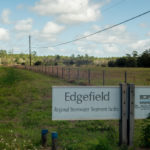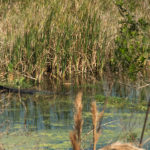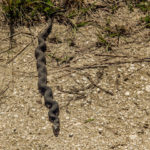By Colton Andre | gargoyle@flagler.edu
Our water systems here in Florida are an essential part of our everyday lives, however as we continue to expand our residential and commercial areas so too does our need to ensure clean and safe water for Florida.
Water affects everything for many, water contains the “essence of life” and to all it is the basis of life. In order to start to understand this valuable resource, I had to meet with a local hydrologist. I found Ty Heidelberger, a Level 4 Hydrolic Data Collection Specialist with the Saint Johns County River Water Management District, off a two-lane road in a gravel parking lot at the Edgefield Regional Stormwater Treatment Facility.
Located in Eastern Putnam County in the town of Palatka, this 212 acre plot of land is home to a 25 acre wet-detention pond and a 56 acre treatment wetland full of bird life, alligators, and snakes. This location has been functional from late 2007 when the program started to treat runoff from local farms, most of which is commonly full of toxic pesticides and fertilizers, before it can return into the waterways and enter our own systems. The plot is adjacent to Dog Branch Creek which a Ty explained is a direct link to the Saint Johns River. I met with Ty to go through his job of collecting data that is used to base moves to protect our waterways and ourselves.
Ty has been doing hydrology work for the St. Johns County River Water Management District for eight years and is about to move up another level. His great passion for protecting and preserving our natural water systems was evident without mention. He takes his job seriously–enough to absorb the work of a few different jobs that couldn’t be kept when the stock market crashed. However data collection remains his main goal and remains the base of all scientific research; if not done with a certain degree of seriousness, the consequences could be fatal for Florida’s future.

After spending 2o years in the technology field, Ty is so comfortable with the systems that even repairs many he finds defunct in the field. He once served as a submarine sonar technician with top secret clearance, but he left the tech industry to open a landscaping business here in Florida where he followed his passion of horticulture.
Over the years he was taken aback by the naivety of many of his customers who had no care for their effects on the local ecosystem, so when he saw a job posting online, he took the opportunity to use his experience and passion to address our local hydrology issues.

Ty explaining the technology behind the recordings.
As a data collection specialist, Ty monitors rivers, streams, lakes and aquifers in Saint Johns County for their flow levels. He does this by using a variety of SonTec sonar systems with which he records water volumes by recording the speed of particles passing by the sonar system. The recorded levels are then put through several data processing systems in accordance with the USGS standards before being analyzed and compared to previous recordings.

Our moving boat system in action.
After showing me around the Edgefield facility, we headed the for Dog Branch Creek where we were able to clear an area for a moving boat system that we would use to record our data. Ty had several systems with him for varied scenarios in which the physical attributes of a location can affect the type of equipment used.

Looking up a section of Dog Branch Creek from one of Edgefield’s discharge areas.
The moving boat rig took about 30 minutes to set up and calibrate before we could start recording. After measuring the salinity and temperature of the water, we initiated the program and recorded data for another 15 minutes by feeding the boat to and from the creek’s shores while receiving a live view of the waters depth and data being received.
We ran our findings into the processing system, packed up and took a moment to enjoy our beautiful surroundings. Admitting that he never really has the time to sit and enjoy what he is working to save, Ty welcomed the opportunity to slow down and take it all in. As for the data, it is being processed back at his office by a team of professionals who will now look at his findings along with records and other data recordings to begin the process of analyzing our affects on water and determining how we can insure its quality for generations to come.






Be the first to comment on "Protecting our waterways"